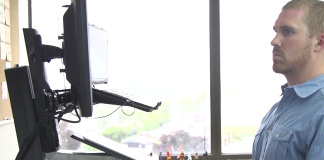Prescription safety glasses become essential equipment for workers in a risky environment or performing activities that potentially endanger their eyes. It doesn’t matter whether you bought your prescription safety glasses online or offline. Right care and maintenance are very important to ensure their performance and lifespan. In this comprehensive guide on caring for your prescription safety glasses, we will cover the dos and don’ts of keeping your glasses in tip-top shape by stressing the need for clear vision with maximum protection.
Essential Things You Should Do
#1 Clean Regularly with Mild Soap and Water
Use lukewarm water and mild soap to wash your safety glasses. Remember, however, to keep them away from direct heat. However, you should refrain from using harsh chemicals and abrasive cleaners, which can damage the lens and coatings.
Use your fingers teasingly to clean up the lenses and the frames from dirt, dust and glands built up while wearing them. Rinse thoroughly under clean water so that no soap residue is left behind. The soap residue, if left, can irritate or affect your visibility.
#2 Use a Microfiber Cloth for Drying
After finishing cleaning, use a microfiber cloth that is supposed to be clean and contain no threads, and pat your glasses dry. Microfiber cloths are the best alternative here because of their softness and smoothness, so you shouldn’t worry about your phone getting scratched or smudged. In the case of the lens, do not use paper towels or anything with lint, particles, or scratch marks, which can interfere with cleaning the lens.
#3 Store Properly When Not in Use
Ensure that the glasses are always kept in a durable case hard case when not traveling and as long as they are not used to protect them from scratches, hits, dirt, and dust.
Ensure that the goggle case is not wet, dry your glasses before they are packed inside, and regularly throw away the dirt off them to avoid dirt deposits.
Find a place to keep your safety glasses where they will not be in the sun or bad temperature, which can damage optics and sensitive materials. Some situations may lead to diminished performance and even breakage of lenses or frames.
#4 Inspect for Damage Regularly
Regularly, it is important for you to examine your glasses and look for any obvious indications of damage or lack of performance. It’s worth the effort to look carefully for any dents, cracks, loose screws or broken frames since these things can make your protective eyewear ineffective.
Be sure that glasses are well manufactured and that a professional conducts all relevant matters, such as repairing damaged or replacing lenses.
#5 Follow the Manufacturer’s Instructions
Make yourself conversant with all the regulations and recommendations provided by the manufacturer’s user manuals and your safety glasses’ prescription guide.
Don’t forget to abide by those restrictions concerning the cleaning techniques, maintenance practices, and recommended lens and frame period.
Things that You Should Avoid
#1 Use Harsh Chemicals or Abrasives
Don’t use chemical disinfectants, strong dissolving agents, and abrasive chemicals, as they may damage the lenses, coatings, and frames of your prescription sports glasses. The ammonia, sodium hypochlorite and acetone in chemicals may result in poor shading, discoloration, loss of frame coating and fading.
Use soaps and solutions made with warm water and gentle surfactants that clean effectively and do not cause any harm to the environment.
#2 Wipe Lenses with Rough Materials
Avoid wiping the lenses of your safety glasses using rough or jagged surfaces because they can make the lenses’ clarity poor and affect your view. Paper towels, tissues, and any other material with small particles or rough fabrics capable of scratching the lenses should be avoided.
To retain the clearness of your sight and the integrity of your glasses, use cloths of soft and microfiber materials designed exclusively for cleaning your glasses.
#3 Exposure to Extreme Conditions
Extreme sunlight, high temperatures and excess moisture or humidity should not affect the prescription safety glasses – they are specifically designed for such conditions.
For extended periods, lenses can be discolored and can get distortions or structural alteration in the glass due to exposure to the sun and high temperatures.
The moisture and the lenses might cause some issues, such as mold growth, corrosion of metal elements, and discoloration of the lens coating.
#4 Neglect Regular Maintenance
Not keeping the proper care and servicing guidelines for your Rx safety glasses will result in a decline in performance and longevity at some point.
If cleaning safety glasses is not done periodically, the lenses become useless, give an uncomfortable feeling, and become a good defense to them.
#5 Ignore Professional Advice
Under no circumstances should you forsake professional advice concerning prescription lenses if you develop any challenges with them. Moreover, do not proceed with repairing your eyeglasses yourself since this may lead to damage to the lenses and the glasses. Make an appointment with a licensed optician or eyeglass expert who can inspect your frames and provide a fix as and when required. If you do the work without going through the proper training and education in that field, you could end up making the damage to the safety eyewear worse and rendering it unusable.
Way Forward
Since safety glasses form the core of personal protection equipment, which should be worn by workers in workplaces with eye safety on top of the priority list, they are a must. Following the instructions in this manual ensures the durability and efficiency of the protective glasses you buy online or at a local shop. Invariably, you would follow the manufacturer’s instructions: stay away from strong chemicals and rough materials; check your glasses thoroughly for defects and store them in a dry place while not in use; and wash them regularly using mild soap and water. With good care, you are 100% protected, and you have the opportunity to see clearly. You have to be careful when buying safety glasses online.










